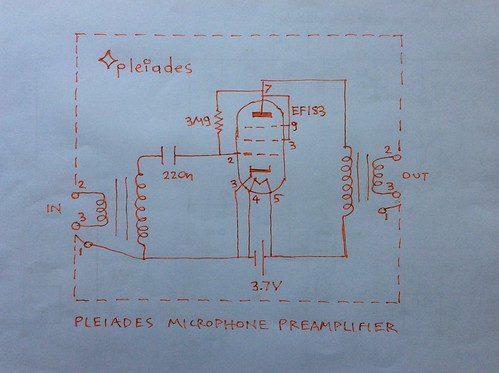Using the Pleiades V6 schematic:

Cc is 22nF.
The anode to grid pull up or Pleiadss bias resitor was removed.
Signal,path, setup:
Male voice singing at 6-12in - Sennheiser MD441 U3 - Pleiades V6 with EF183 open grid, Altec 4722 mic input transformer, Pleiades 10:1 Magnetec 070 output transformer - Sony TC-D5 Pro - Sennheiser HD580
Initially 10V was connected as plate supply.
The anode current is 45μA and the sound is great and low noise.
Next a total of 24V was connected as plate supply. Anode current jumped to 400μA. In a few minutes it went to 500μA.
The sound was low noise. Perhaps a more hard sound.
This is possibly an unfair test as at 500μA anode current the output transformer (non air gaped) core would have been saturated by the DC field.
The batteries of the Sony TC- D5 went down, distortion entered and the experiment had to come to a halt.
A first impression is that the 45μA plate current gave again a great, balanced and low noise sound.
It is impressive applying heater voltage (through fuse for safety) and waiting for the sound to come. The bid sound and ambience reminds world class electron tube underheated condenser microphones such as AKG C12A.
A great sound comes too if plate supply is 3.9V with Pleiadss bias again achieving approx 50μA anode or plate current. The anode to grid resistor in this case is 6MΩ. See older post on Pleiades V6 with EF183.
The impression again is that what is important is a fairly loa but healthy anode current (such a 47μA) not how one gets there.
See also some electrometer measurments of the EF183 grid on tomorrow's post:
http://euroelectron.blogspot.com/2018/08/some-measurments-on-ef183-open-grid.html
Further reading:
The Pleiades Bias - euroelectron
Open grid tubes in low level amplifiers - Robert J. Meyer - Electronics - October 1944
No comments:
Post a Comment